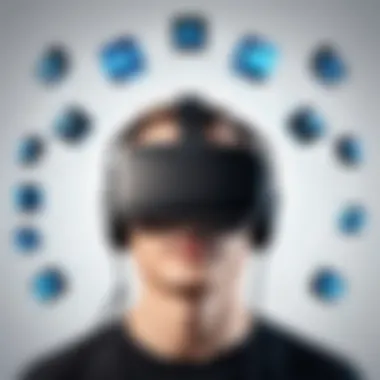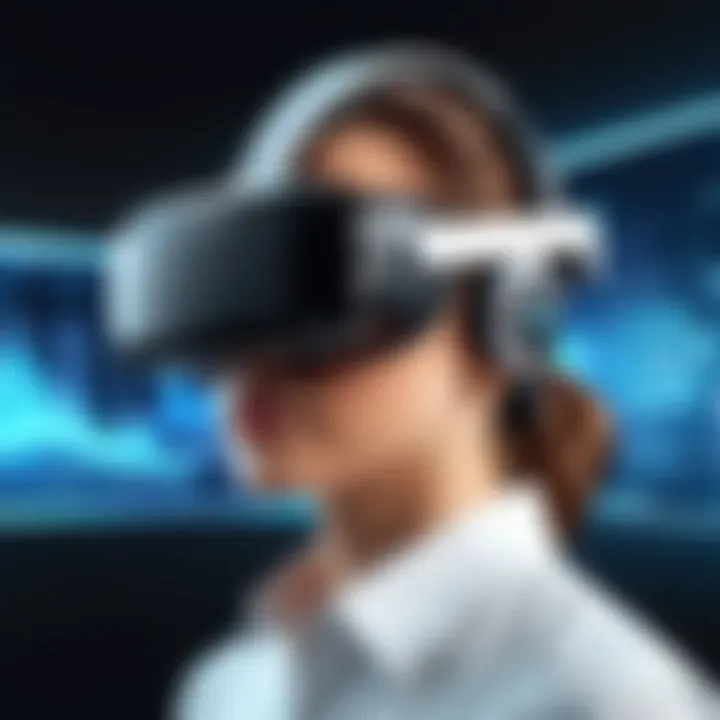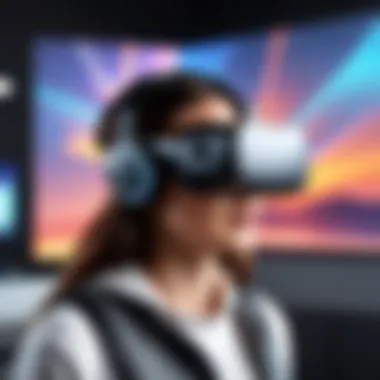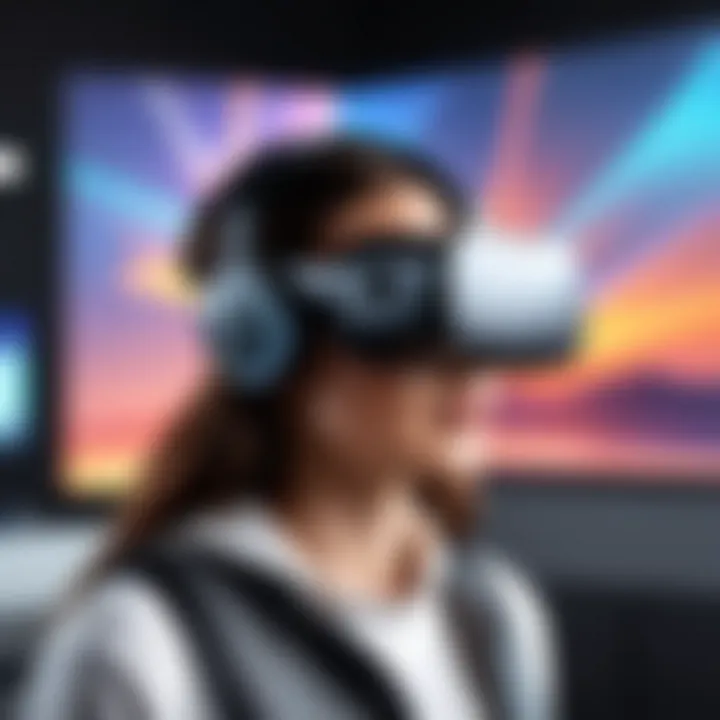Examining Top Virtual Reality Platforms in 2023


Intro
In today's fast-paced world, the impact of virtual reality (VR) cannot be overstated. The landscape is rapidly evolving, and with it, the technology behind VR platforms is becoming more sophisticated. From immersive gaming experiences to innovative training simulations across multiple domains, what was once a mere novelty is now a cornerstone of interactive technology. The multitude of virtual reality platforms – each offering unique features and user experiences – are reshaping how we engage with digital environments.
As we peel back the layers of this thriving sector, this article delves into the leading VR platforms on the market today. It shines a light on their functionalities, highlights their advantages and limitations, and compares them in a way that serves the interests of software developers, IT professionals, and students alike. Without further ado, let's roll up our sleeves and get into the nitty-gritty of the software that’s transforming our virtual interactions.
Software Overview
Features and Functionalities Overview
When exploring virtual reality platforms, one must consider the diverse features that set each apart. Key functionalities typically include real-time tracking, high-resolution graphics, and social interactivity. For instance, Oculus Quest offers a powerful standalone experience, enabling users to dive into immense worlds without the need for a gaming PC. Meanwhile, platforms like HTC Vive excel in room-scale tracking, giving users freedom to move around in large spaces.
On the other hand, PlayStation VR stands out with its extensive library of games tied to the PlayStation console, creating an unrivaled ecosystem for enthusiasts.
User Interface and Navigation
Simplicity can often enhance the user experience dramatically. Take, for example, the intuitive dashboard on the Valve Index, designed with clarity in mind, making navigation seamless for new users. Contrast this with other platforms that might have convoluted menus, which could potentially frustrate users instead of engaging them. Clarity and straightforward navigation are vital, especially when a user's environment is a reality-bending virtual space.
Compatibility and Integrations
Compatibility can be a make-or-break factor for many users. Platforms like Oculus and HTV Vive support a wide range of games and apps, promoting versatility in user experiences. Notably, many of these systems integrate well with popular software ecosystems like SteamVR, giving users access to a plethora of content. Operating smoothly across different devices ensures that users are not left high and dry when they want to explore different applications or participate in collaborative experiences.
Pros and Cons
Strengths
The advantages of these platforms are numerous; however, a few stand out prominently:
- Diverse Application: Beyond gaming, VR is utilized in education, healthcare, and architecture.
- High Engagement: Users report elevated engagement levels while using immersive experiences.
- Community Building: Many platforms foster strong online communities where users can share and collaborate.
Weaknesses
However, it's essential to acknowledge shortcomings:
- Physical Space Requirement: Some platforms require significant room to maneuver, limiting user experiences.
- Technical Barriers: Not every user has access to high-performance hardware, which can cause limitations on experience quality.
- Cost Factors: High initial investments may deter potential users.
Comparison with Similar Software
When juxtaposed with each other, these platforms reveal strengths and weaknesses quite clearly. For instance, while the Oculus Quest is fantastic for standalone use, platforms like HTC Vive are more suited for those who prioritize superior graphics and immersive tracking. This varies according to user needs, as some may prioritize portability while others seek the most refined graphical experience.
Pricing and Plans
Subscription Options
Pricing structures are a significant consideration. Various platforms approach this differently. Oculus Quest provides a straightforward purchase model, while platforms like HTC Vive offer subscriptions for specific experiences, which may be appealing for casual users.
Free Trial or Demo Availability
Several platforms now offer demo experiences, which can be highly beneficial for users who are on the fence. For instance, many gaming centers allow users to test VR setups, giving them a taste before making a hefty investment.
Value for Money
Ultimately, assessing value for money depends on individual use cases. Users heavily invested in VR will find that their investment pays off through exclusive experiences and continuous updates, while casual users may not get as much return.
Expert Verdict
Final Thoughts and Recommendations
Considering the rapid advancements in virtual reality technology, each platform’s unique blend of features, usability, and community engagement shines through. For developers and IT professionals, evaluating these platforms becomes even more critical as they shape the future of interactive technology.
Target Audience Suitability
While gamers largely populate the VR landscape, students and professionals looking for training simulations also stand to benefit immensely. Specific platforms cater better to educational environments, offering tools designed for learning.
Potential for Future Updates
The potential for future development is enormous. New updates could lead to better hardware integration, enhanced graphical capabilities, and more content that could create even richer environments. Keeping an eye on these platforms could yield fruitful opportunities for early adopters.
Considering these insights, it becomes clear that the world of virtual reality platforms is both diverse and integral in shaping tomorrow's technology.
Intro to Virtual Reality
Virtual reality has carved a niche that goes beyond simple gaming. It stands at the intersection of technology and emotional engagement, paving the way for extraordinary experiences. The importance of understanding virtual reality in today’s context cannot be overstated. As technology advances, the platforms available for immersion into VR continue to evolve, offering a myriad of applications beyond entertainment. From education to therapy, the impact of VR permeates various aspects of life, making it critical for IT professionals, software developers, and students to be well-acquainted with these developments.


In this article, we delve into key components of virtual reality, examining what defines it and how it has transformed over the years. By showcasing the leading VR platforms, we aim to shed light on their unique offerings, benefits, and considerations that voice the sentiments of experienced users. This will not only facilitate a deeper comprehension of the technology but will also assist in making informed decisions regarding platform usage, development, or integration.
Defining Virtual Reality
At its core, virtual reality is a computer-generated environment where users can interact in a seemingly real way. Through specialized hardware like headsets and motion sensors, users can enter a digital space, engaging with it as though it were part of their world. This environment is captivating, drawing individuals in with a sense of presence that traditional media simply cannot provide. In essence, VR aims to create an immersive experience that overwhelms the senses, giving a feel of actually being somewhere else.
Key aspects include:
- Immersion: This refers to the sense of being enveloped by the virtual environment.
- Interaction: Users can manipulate objects and navigate the virtual world using various interfaces.
- Realism: High-quality graphics and sound contribute to the immersive quality of the experience.
- Agency: The ability to make choices and see the consequences in real-time enriches the user’s engagement.
Historical Context and Evolution
To appreciate where virtual reality stands today, it's crucial to understand its history. VR didn't emerge from a vacuum; it evolved through decades of technological advancements and conceptual breakthroughs. The journey began in the 1960s with simple simulations, such as Ivan Sutherland's "Sword of Damocles,” which, albeit rudimentary, showcased the vast potential of immersive environments.
By the 1980s, the idea of virtual reality garnered attention in academic circles, yet it faced challenges in practical applications. Fast-forward to the late 1990s, and companies like Sega attempted to bring VR to mainstream gaming, though with limited success due to the constraints of the technology at that time.
However, the real turning point came in the 2010s when the frameworks for VR began to solidify. With the introduction of the Oculus Rift, interest in VR surged dramatically, bolstered by advancements in graphics, processing power, and accessibility of VR equipment. Companies like HTC, PlayStation, and Valve followed suit, each adding their flavor to the realm of virtual reality.
"Virtual reality is an extraordinary blend of computer science and art; it opens the door to not just new games, but new ways of thinking and being."
As the hardware continued to innovate, software developers were emboldened to create rich, interactive experiences. The technology not only improved in fidelity but also became more user-friendly, paving the way for broader adoption across industries. Today, the landscape is teeming with various platforms providing distinct features and functionalities, creating a diverse ecosystem that is ripe for exploration.
In summary, diving into the world of virtual reality not only unearths fascinating technological advancements but also lays the groundwork for future innovations in how we interact with digital content. Understanding its definition and evolutionary journey will serve as the backdrop for examining the leading platforms available today.
Overview of Leading VR Platforms
In the rapidly evolving realm of technology, virtual reality (VR) platforms stand out as both marvels of innovation and crucial tools for various applications. Understanding these platforms is essential for anyone interested in technology, gaming, education, or even healthcare. They are not just for entertainment; they have implications that stretch across numerous industries, revolutionizing how we interact with digital content and with each other.
The significance of this section lies in its ability to present a comprehensive landscape of the VR ecosystem. By highlighting leading platforms, we can investigate critical elements such as market trends, user bases, and the technologies that underpin these systems. This knowledge equips professionals, software developers, and students with the insights necessary for navigating the complexities of VR.
Key Players in the Market
Several companies have carved out a significant presence in the VR space, each bringing its own style, vision, and technological prowess to the table. Some of the most notable players include:
- Meta (formerly Facebook): The Oculus series, particularly the Quest line, has made waves with its user-friendly approach and strong content offerings.
- HTC Vive: Known for its premium hardware and immersive capabilities, the Vive line appeals to both gamers and developers looking for high-end experiences.
- Sony PlayStation VR: Tapping into its vast gaming ecosystem, PlayStation VR garners attention from console gamers, supported by a solid library of exclusive titles.
- Valve: With the Index, Valve has pushed boundaries, focusing on precise tracking and innovative hardware features, which attract a niche audience of serious gamers.
The interplay between these competitors shapes the VR market and influences technological developments. Each platform's strengths and weaknesses contribute to a dynamic environment where innovation can thrive.
Market Share Analysis
Analyzing market share provides a clear view of how different platforms perform and their broader market acceptance. According to recent statistics, Meta dominates the landscape, thanks largely to the popularity of its Oculus Quest series. Approximately 75% of the market share is attributed to Meta, emphasizing its role as a leader in consumer VR. In contrast, HTC and Valve maintain a smaller, but fiercely loyal segment of users attracted to their unique offerings and features.
- Market Share Distribution:
- Meta: 75%
- HTC: 10%
- Sony: 8%
- Valve: 5%
This environment of competition fuels innovation, as companies spend heavily on research and development to capture larger shares of this emerging market. The ongoing upgrades and release of new models reflect this ambition, as platforms vie to entice users with enhanced features and exclusive content.
As we delve deeper into the leading platforms, understanding these dynamics will be crucial for identifying trends and anticipating future developments in the virtual reality arena.
"The landscape of virtual reality is continually shifting, revealing new opportunities for engagement and innovation. Keeping abreast of market movements is essential for any tech-oriented professional."
Oculus Platform
The Oculus Platform, developed by Oculus VR, a subsidiary of Facebook Technologies, has emerged as a significant player in the virtual reality domain. Its impact on both the consumer and developer landscapes can’t be understated. With a focus on accessibility, cutting-edge technology, and immersive experiences, the Oculus ecosystem is designed to cater to a diverse audience, from casual gamers to serious developers.
One of the important aspects of the Oculus Platform is its adaptability. It can run on various devices and systems, paving the way for broader usage. Its commitment to innovation is shown through ongoing updates and support for developers.
Additionally, one cannot ignore the extensive library of content available, which highlights the platform's emphasis on variety and quality in user experiences. This section delves deeply into the features, user experience, and applications of the Oculus Platform.
Features and Functionalities
Oculus Platform boasts a range of features and functionalities that set it apart. Here are some core features:
- High-Quality Graphics: Oculus devices leverage advanced technology to deliver stunning visuals for an immersive experience.
- Room-Scale Tracking: Allow users to move freely within a designated space, enhancing the interactive experience.
- Multi-Platform Support: The Oculus ecosystem supports various applications across platforms, from gaming to education.
- Social Experiences: With integration into the Facebook ecosystem, users can socialize and share experiences with friends.
A notable functionality is the Oculus Link, which connects Oculus Quest to a gaming PC, combining the best of both standalone and tethered experience. This seamless merging allows users to access a wider range of VR content while benefiting from the portability of the standalone headset.
User Experience Insights
From a user perspective, the Oculus Platform has garnered a positive reputation but not without some criticisms. User experiences often revolve around several key aspects:
- Intuitive Interface: Users frequently commend the straightforward navigation and ease with which one can access content.
- Immersion Factor: The immersive nature of the platform effectively transports users to different worlds, making for compelling usage.
- Occasional Connectivity Issues: Some users have reported challenges regarding connectivity, especially when utilizing Oculus Link.
Feedback from user forums like reddit.com suggests that while the initial setup can be daunting, many find the involvement ultimately rewarding, especially after familiarizing themselves with the controls.


Applications in Various Fields
Oculus has positioned itself not just as a gaming platform but a versatile tool applicable to multiple industries. Key applications include:
- Education: Institutions leverage VR for a more engaging learning environment. Students can experience histories or scientific concepts dynamically through immersive simulations.
- Healthcare: Medical professionals utilize VR for training and patient treatment, enabling practice scenarios without real-world consequences.
- Real Estate: Virtual tours have changed the way agents showcase properties, allowing buyers to explore homes in a detailed manner from anywhere.
"The integration of Oculus technology into various fields bears witness to the transformative potential of VR that goes beyond entertainment."
Oculus continues shaping how we perceive digital interaction and entertainment, standing as a robust platform backed by technology and community support. As developments in VR technology accelerate, the Oculus Platform remains pivotal in the paradigm shift towards virtual experiences.
HTC Vive
The HTC Vive stands as a notable contender in the landscape of virtual reality platforms, carving out its niche through innovation and a focus on immersive experiences. This platform is pivotal in understanding the progression of VR technology, as it has continually pushed the boundaries of what consumers can expect in terms of realism and engagement. Moreover, the HTC Vive has attracted a robust user base, ranging from gaming enthusiasts to professionals who utilize virtual reality in diverse fields such as education and healthcare.
Unique Selling Points
HTC Vive distinguishes itself with several notable features that elevate it above its competitors:
- Room-Scale VR: This feature allows users to move freely within a designated space, creating a sense of true immersion. The tracking technology is sophisticated, ensuring that movement in the real world translates seamlessly into the virtual environment.
- High-Resolution Displays: The quality of visuals in VR can make or break the experience. The Vive delivers stunning images with high pixel density, reducing the screen-door effect that can detract from immersion.
- Intuitive Controllers: The Vive controllers are ergonomically designed and provide haptic feedback, enhancing user interaction. This design allows for natural motions, making it easier for users to grasp the virtual world around them.
"HTC Vive is not just a tool for entertainment; it represents a bridge to new experiences and environments that were previously unimaginable."
- Strong Content Library: With a plethora of games and apps available through the Steam platform, users have access to an expansive range of content. This variety caters to different interests, from casual games to educational software.
Each of these features contributes to HTC Vive's strong standing in the market, emphasizing not only entertainment but also the potential for VR in professional settings.
Compatibility with Other Software
An important factor for any VR platform is its ability to integrate with existing software ecosystems. HTC Vive excels in this aspect by:
- SteamVR Compatibility: This platform is fully integrated with Steam, one of the largest distribution services for PC gaming. This means users can seamlessly access a vast array of content specifically designed for virtual reality.
- Open Development Environment: HTC encourages developers to create for the Vive using a range of development kits and tools available. This promotes innovation, as developers can easily build and adapt applications to run on the Vive without extensive barriers.
- Support for Diverse Software: Beyond gaming, HTC Vive supports various applications in fields such as architecture, design, and healthcare. Programs like Tilt Brush for creative design and medical simulations showcase the versatility of the Vive platform in professional settings.
PlayStation VR
PlayStation VR stands as a significant pillar in the landscape of virtual reality platforms. Launched by Sony, this platform caters to a wide array of users ranging from avid gamers to developers looking to explore interactive experiences. The importance of PlayStation VR in this article stems from its unique position within the gaming industry, enabling access to a content library that resonates with both casual and hardcore gamers.
Target Audience and Content Library
One of the standout features of PlayStation VR is its target audience. Unlike other platforms that may cater solely to niche markets, PlayStation VR taps into the vast community of PlayStation console users. This sets it apart by allowing many people to delve into virtual reality without needing a high-end PC.
The content library is another critical element. Sony has invested heavily in developing a diverse range of experiences from action-packed games to immersive storytelling titles. Popular games such as "Beat Saber" and "Astro Bot Rescue Mission" showcase the platform's versatility and appeal. Moreover, the availability of titles that appeal to a variety of age groups strengthens its market position, making it a go-to platform for families and individuals alike.
Furthermore, the integration of PlayStation 4 and PlayStation 5 games with VR capabilities opens the door for existing users to easily transition into the virtual realm. This synergy contributes to a sustainable content ecosystem.
Technical Specifications
When it comes to technical specifications, PlayStation VR is designed for efficiency and connectivity. It operates on a combination of 1920 x 1080 resolution, providing clear visuals that bring games to life. The headset features a 90 to 120 Hz refresh rate, ensuring smooth motion tracking. These specifications are crucial because they enhance the overall immersive experience.
Its design emphasizes comfort as it can be worn for extended sessions. With features such as adjustable lenses and a lightweight structure, it accommodates various head shapes and sizes.
In terms of connectivity, PlayStation VR requires a PlayStation camera for motion tracking, which adds an extra layer of interaction not available on mobile VR systems. The ability to utilize Move controllers or the DualShock controller further enriches the gameplay, making it feel more intuitive.
Valve Index
The Valve Index is a significant player in the realm of virtual reality. It's not just another headset; it represents a serious attempt to push the boundaries of what VR can do. This section will explore some specific elements that make the Valve Index stand out, its highlighted benefits, and important considerations for users and developers alike.
Innovative Features
The Valve Index differentiates itself from its competitors through its cutting-edge features. One of the most noteworthy innovations is the high refresh rate, capable of reaching up to 144Hz. This feature enhances the immersion, allowing for smoother graphics and reducing motion blur, which is crucial during fast-paced experiences. Imagine diving into an action-packed game and feeling every movement clearly without the headache of lag.
Moreover, the field of view on the Index is quite impressive; it offers a wider range compared to many of its contemporaries. Users can enjoy a more extensive view of their virtual environment, creating a feeling of being truly present within the game or simulation. Some users have remarked that the wider field of view allows for a more "naturally engaging experience."
Another innovative offering is the finger-tracking controllers. These controllers not only respond to the movements of the user's hand but can also sense individual finger movements. This creates a richer interaction, enabling gestures, grips, and even complex movements that feel incredibly intuitive.
In addition to these features, the Index is known for its superior audio solution. The off-ear speakers deliver crisp sound without isolating the user from their physical surroundings, making for a more immersive atmosphere while still keeping them aware of their real-world environment.
Community Engagement and User Contributions
The success of the Valve Index is not just about the hardware; it's also about the vibrant community that surrounds it. Users play a crucial role in the platform’s evolution. For instance, one can find various forums and discussion boards, like those on Reddit and Steam, where developers and enthusiasts share mods, tips, and unique applications. This community-driven approach allows for a rapid exchange of ideas and innovations.
Valve encourages community contributions, which fosters an ecosystem where users can help shape the experience. From custom game mods to recommendations for optimizing performance, the community shares resources that enrich the overall experience. This collaboration results in a sort of ever-evolving library of content and insights, enhancing the base value of the Index.
"The Valve Index is not just a product; it’s a community project that grows with its users."
Furthermore, Valve's consistent attention to user feedback is noteworthy. Developers often implement updates that address common user concerns formulated from community discussions. This responsiveness not only builds loyalty but also ensures ongoing compatibility with new software and technologies.


Comparative Analysis of Platforms
In the ever-evolving landscape of virtual reality, conducting a comparative analysis of platforms is more than just a necessary step; it's foundational for anyone keen to navigate this technological maze. This section sheds light on how different VR platforms measure up against one another with respect to key performance metrics and cost considerations. Performing such an analysis reveals not only strengths but also weaknesses, offering potential users insights that can influence their decisions significantly. For developers, knowledge of platform capabilities helps tailor applications to suit specific environments while assessing market viability.
Performance Metrics
When discussing performance metrics in VR platforms, several factors need to be taken into account. These metrics can include, but are not limited to:
- Frame Rate: A higher frame rate leads to smoother visuals, enhancing the immersive experience. Platforms that deliver consistent 90-120 FPS are generally preferred.
- Latency: Low latency is crucial because it reduces lag between user input and visual feedback, which is essential for preventing motion sickness.
- Resolution: Higher resolution provides clearer images, allowing for a more engaging and realistic experience.
- Field of View: A broader field of view makes the environment feel more immersive, as users can see more of their surroundings without moving their heads.
- Tracking Accuracy: Effective tracking translates to a more responsive interaction with the virtual environment, pivotal for an immersive experience.
For instance, if we compare the Oculus Quest 2 with the Valve Index, the Quest 2 excels at portability and ease of use, while the Valve Index shines in fidelity and tracking. In this way, understanding these metrics can help users choose a platform that aligns with their particular needs, whether for entertainment, professional use, or educational purposes.
Cost-Benefit Considerations
Cost is often a determining factor in the decision-making process when considering VR platforms. Users must weigh not only the upfront costs but also ongoing expenses against the expected benefits.
- Initial Investment: Platforms like PlayStation VR typically require a gaming console, while others like the Oculus Quest 2 function standalone, which could lower initial costs for some users.
- Software Availability: Ensuring that the platform has a rich library of software can justify the purchase price. One with limited titles might lead to buyer's remorse regardless of hardware quality.
- Accessories: Some platforms necessitate extra accessories—like hand controllers and sensors—pushing up the total cost of ownership.
- Longevity and Upgrades: Platforms that are regularly updated or integrated with new technologies might provide better long-term value, making it important to assess future-proofing capabilities.
It’s vital to recognize that while a budget option may seem appealing, the overall value is determined by the experience it provides, which includes hardware performance and the richness of available content.
In summary, the comparative analysis of VR platforms reveals essential insights for potential users. It goes beyond mere numbers, driving home the importance of user experience, content richness, and long-term value, especially in a field that changes as rapidly as virtual reality.
User Community and Support Ecosystem
In the landscape of virtual reality platforms, the user community and support ecosystem is akin to the lifeblood that sustains and propels these technologies forward. A vibrant community not only enhances user comfort but also accelerates innovation. When users share their addresses with problems or triumphant moments, it creates a channel for feedback that can shape the direction of future developments. It's like planting seeds in a garden; with time, care, and interaction, these seeds can robustly bloom into a diversified experience for all users.
Moreover, the support ecosystem in VR platforms serves as a cornerstone for user satisfaction and engagement. Users often find themselves in uncharted waters when exploring new virtual realms. Understanding how to navigate the myriad of features can be daunting. Thus, having a solid support system can build trust, loyalty, and a sense of belonging amongst users.
Forums and Online Communities
Online forums and communities are where the magic happens. This is a space for users to converge, share tricks, and troubleshoot issues together. Platforms like Reddit host a plethora of subreddits tailored specifically to various VR systems, from Oculus to Valve Index. Here, individuals can post inquiries, share experiences, or simply engage in light banter. This informal sharing environment allows users to learn from one another and adapt their approaches based on real-world feedback rather than theoretical know-how.
Another noteworthy aspect of these communities is the grassroots innovation that often emerges. Many users aren't just passive consumers; some become creators themselves. They can develop mods, share games, or even provide custom content that enriches the overall experience. That's a domino effect - one idea can spark countless others, keeping the ecosystem lively and fresh.
Additionally, active forums often catch the ears of developers who seek insights into user experiences. This creates a two-way street of communication that can lead to practical improvements in the platform itself. In essence, these communities serve as advisory boards, always ready to provide constructive criticism or affirmations that can foster enhancements.
Customer Support Channels and Resources
On the other side of the coin lies customer support—it’s the safety net that catches those who might stumble while leaping into virtual environments. The quality of customer support varies significantly across VR platforms, and this directly impacts user retention and satisfaction. Effective support channels—be it chatbots, email support, or direct phone lines—are invaluable when users encounter hurdles. Imagine trying to solve a technical glitch during an immersive session; immediate help can salvage the experience.
Most platforms have set up dedicated support pages inundated with resources such as FAQs, guides, and troubleshooting articles. These resources often come in handy, allowing users to self-diagnose and rectify standard issues without waiting for a response from support personnel. However, sometimes the need for human interaction is paramount, and having quick access to knowledgeable support agents can turn a potentially frustrating experience into a manageable one.
Future Trends in Virtual Reality
Staying attuned to the emerging trends in virtual reality is crucial for understanding the future landscape of technology and its applications. As the industry rapidly evolves, identifying what lies ahead helps developers, investors, and enthusiasts strategize and innovate effectively. In this section, we delve into some specific advancements anticipated in VR technology and explore how shifting market dynamics will shape user experiences and platform adoption.
Predicted Technological Advancements
In the realm of virtual reality, the upcoming technological advancements promise to enhance immersion and interactivity, driving user engagement like never before.
- Increased Resolution and Visual Fidelity
As display technology progresses, we can expect VR headsets to boast higher resolutions, creating crisper visuals without the screen-door effect that concerns some users today. The leap in visual quality will heighten realism, making virtual environments more attractive and appealing. - Haptic Feedback Innovations
Haptic technology is set to make significant strides, allowing users to feel virtual interactions through advanced touch interfaces and feedback systems. Imagine sensations like the warmth of a virtual sun or the force of an in-game weapon—haptic feedback will anchor users deeper into their experiences. - More Social and Collaborative Features
Virtual reality is moving towards a more connected future. Platforms will incorporate richer social experiences, enabling people to meet and collaborate in virtual spaces irrespective of their physical locations. This could revolutionize remote work, education, and social networking, transforming VR into an essential tool in everyday life. - AI Integration
The fusion of AI with VR has the potential to personalize user experiences significantly. By learning individual preferences and behaviors, AI-driven algorithms can tailor virtual environments and experiences, enhancing the overall immersion.
"Technological innovation continues to drive virtual reality forward, unlocking new possibilities and redefining boundaries."
- Wireless Capabilities and Standalone Devices
As technology progresses, wireless VR headsets will become the norm, eliminating the constraints of cables and enabling more dynamic and unrestricted movement. Standalone devices, like the Meta Quest series, are paving the way for a mobile VR experience that could appeal to a broader audience.
Potential Market Shifts
As these technologies advance, the virtual reality market is poised for notable shifts that will affect how users interact with VR platforms.
- Consumer Adoption Surge
With enhanced accessibility and better experiences, we are likely to witness a broader acceptance of VR across different demographics. As prices become more competitive, average consumers may find VR headsets appealing for gaming, fitness, or social activities. - Cross-industry Applications
Industries such as healthcare, real estate, and education are exploring the benefits of VR, leading to an expanding market beyond entertainment. Training simulations, virtual tours, and interactive learning environments represent just a glimpse of the potential VR holds in these sectors. - Emergence of Subscription Models
As the competition heats up, platforms may adopt subscription-based models to enrich user experiences. This could mean access to exclusive games, premium content, and other additional features, shifting how consumers perceive the value of VR. - Investment Surge and Startup Landscape
Venture capital will likely continue flowing into the VR landscape, fueling innovation. Startups focusing on niche applications will emerge, driving specialized solutions tailored to unique audiences.
In summary, as we look to the future, technological innovations and market shifts will play integral roles in shaping virtual reality's trajectory. Keeping an eye on these trends can equip stakeholders in IT and software development with the insight needed to ride the wave of the VR revolution.
The End
The role of virtual reality platforms in today’s technology landscape cannot be overstated. The conclusion of our exploration encapsulates the significance of these platforms, as well as the myriad benefits and considerations surrounding them. Throughout this article, recurring themes reveal how VR is not simply a tool for gaming; it spans various applications from education to healthcare, altering how we interact with digital environments and each other.
Recap of Key Findings
In summarizing our key findings, several prominent aspects stand out regarding the leading VR platforms:
- Diversity of Offerings: Each major platform, such as Oculus, HTC Vive, PlayStation VR, and Valve Index, presents unique strengths. Oculus is often lauded for its accessibility and ease of use, while HTC Vive boasts advanced motion tracking capabilities. PlayStation VR appeals to a more casual gaming audience through its extensive content library.
- Technological Innovations: The technological advancements seen over the years, from graphical fidelity to sensory feedback devices, indicate that VR is rapidly evolving. Features like hand tracking and wireless connectivity have reshaped user experience.
- Community and Ecosystem: User forums and online communities have flourished, offering support and sharing of experiences which enhances the overall VR journey. This supportive ecosystem fosters innovation and continual improvement based on user feedback.
Final Thoughts on the Future of VR Platforms
Looking ahead, the future of virtual reality platforms holds immense potential. As technology improves, we are likely to witness:
- Greater Accessibility: Prices will continue to drop, making VR more accessible to a broader audience.
- Innovative Applications: Beyond entertainment, we could see VR becoming a staple in professional training environments, virtual collaborations, and possibly even virtual tourism.
- Integration with AI: The interplay between VR and artificial intelligence may yield unprecedented interactive experiences, allowing for highly personalized content and environments.
In essence, the landscape of VR is expansive and dynamic, creating a conducive atmosphere for future exploration and development. Understanding these platforms today gives insights into how they may positively impact various sectors tomorrow.







